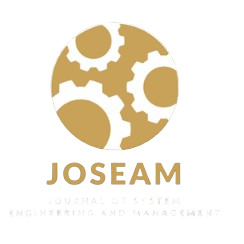"Mapping Potential Hazards: Job Safety Analysis in Lathe Companies"
Abstract
Full Text:
PDFReferences
H. C. Suroso and K. E. Yanuar, “Analisa Potensi Bahaya pada Perusahaan Fabrikasi Baja menggunakan Metode HAZOP (Hazard and Operability Study),” Journal of Advance Information and Industrial Technology (JAIIT), vol. 2, no. 1, pp. 13–21, 2020, doi: https://doi.org/10.52435/jaiit.v2i1.16.
M. M. Ulkhaq and D. M. Putri, “Penilaian Risiko Keselamatan Kerja pada Proses Pembuata Balok Jembatan dengan Metode Job Safety Analysis (JSA),” Industrial Engineering Online Journal, vol. 6, no. 4, 2018.
M. A. Rofiq and A. Azhar, “Hazards Identification and Risk Assessment In Welding Confined Space Ship Reparation PT. X With Job Safety Analysis Method,” BERKALA SAINSTEK, vol. 10, no. 4, p. 175, Dec. 2022, doi: 10.19184/bst.v10i4.32669.
K. P. Dharaka and S. Sriyanto, “Analisis Resiko Kerja pada Pembuatan Kardus Menggunakan Metode Job Safety Analisys (JSA) di CV MD Palletindo Div. [1] H. C. Suroso and K. E. Yanuar, “Analisa Potensi Bahaya pada Perusahaan Fabrikasi Baja menggunakan Metode HAZOP (Hazard and Operability Study),” Journal of Advance Information and Industrial Technology (JAIIT), vol. 2, no. 1, pp. 13–21, 2020, doi: https://doi.org/10.52435/jaiit.v2i1.16.
F. Alfarisi and J. James, “Analisa Penilaian Resiko pada Proses Pengelasan dengan Metode Job Safety Analysis (Studi Kasus: PT. Meindo Elang Indah),” IDENTIFIKASI: Jurnal Keselamatan, Kesehatan Kerja dan Lingkungan Lingkungan, vol. 3, no. 1, 2017.
S. S. C. Balili and F. Yuamita, “Analisis Pengendalian Risiko Kecelakaan Kerja Bagian Mekanik Pada Proyek PLTU Ampana (2x3 Mw) Menggunakan Metode Job Safety Analysis (JSA),” Jurnal Teknologi dan Manajemen Industri Terapan (JTMIT), vol. 1, no. 2, pp. 61–69, 2022.
D. Wulandari and N. Widajati, “Risk Assessment pada Pekerja Pengelasan Perkapalan dengan Pendekatan Job Safety Analysis,” The Indonesian Journal of Occupational Safety and Health, vol. 6, no. 1, pp. 1–15, Nov. 2017, doi: 10.20473/ijosh.v6i1.2017.1-15.
DOI: http://dx.doi.org/10.36055/joseam.v3i1.24917
Refbacks
- There are currently no refbacks.

is supported by
This work is licensed under Creative Commons Attribution-ShareAlike 4.0 International



